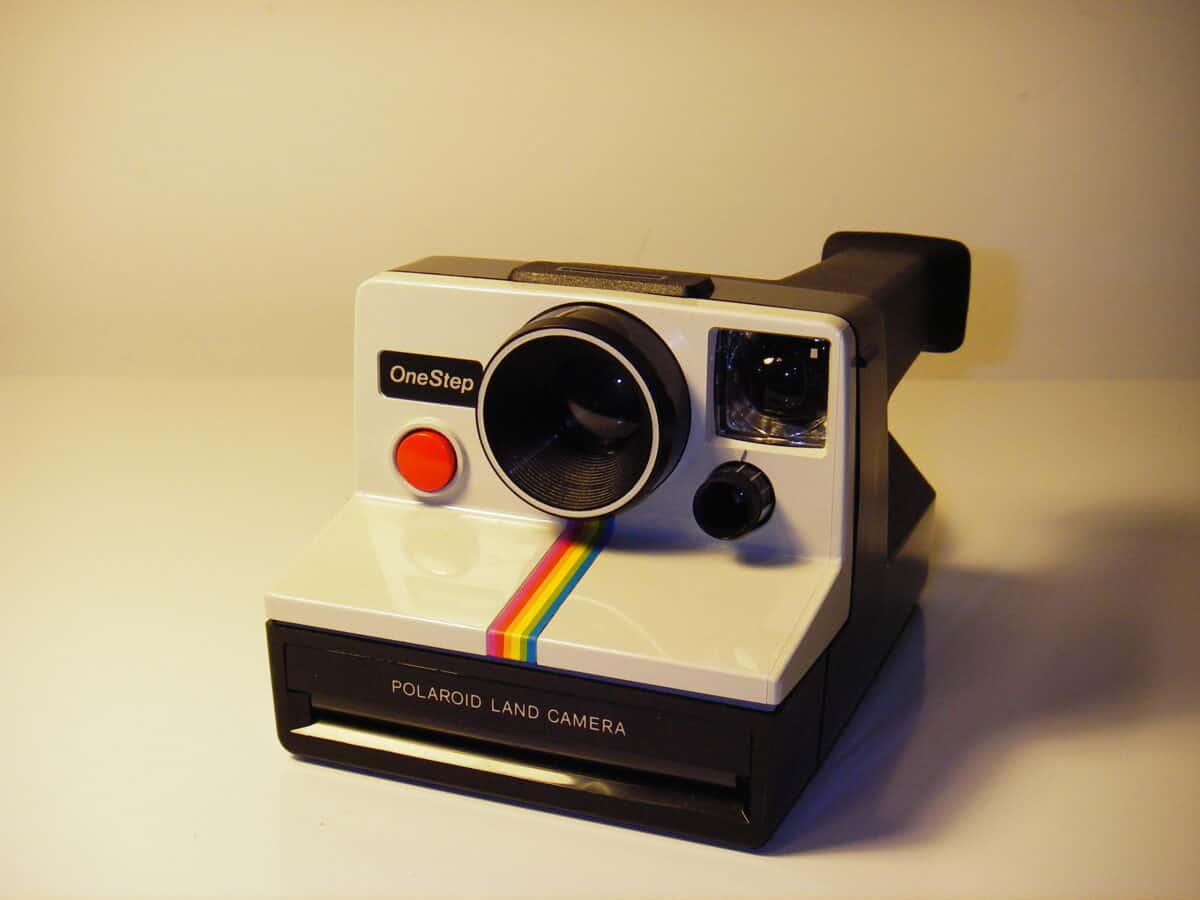Not many companies have the privilege of being synonymous with their product. Kleenex, Xerox, ChapStick, Post-Its… these brands and their products are so popular and recognizable that they apply to all tissues, all photocopies, all lip balms, and all sticky notes, regardless of if they’re made by the brand or not. Polaroid is another one of these companies. The mere mention of the instant camera innovator’s brand name brings to mind their product. This recognizability only makes it more shocking to note that Polaroid failed.
This wasn’t something that just happened overnight, either. Polaroid’s failure was long in the works, forever lingering just underneath the surface of their success. From the outside, Polaroid looked like they were thriving above all the competition throughout the 1980s and ’90s. Underneath all that success, they were speeding toward their inevitable downfall. What led to this? What went wrong? There’s no one answer. There are a handful of valid causes. We’ll explore each one below.
Quick Facts
- Year Founded
- 1937
- Founders
- Edwin Land
- Industry
- Photography
- Headquarter
- Minnetonka, MN
- Key People
- Oskar Smołokowski (CEO)
- Notable Products
- Polaroid Instant Camera
Why Polaroid Mattered
While the technology seems somewhat archaic today, the truth is that before Polaroid failed, it was a revolutionary invention for the mid-20th century. There was nothing like it then, and it stayed that way for decades. Before Polaroid’s instant camera, films had to undergo extensive processing before the camera’s photos could come out. First, the capture on film. Then, the completion of the roll of film. After that, the careful extraction of the film. Then, the development of the film in a special dark room. The photos would then have to dry. Only then could you see what you’d shot.
With the creation of the Polaroid instant camera in 1948, photography was effectively changed forever. Its significance cannot be overstated. Now, with a Polaroid, photographers could expect to see their photos as soon as they were captured. There wouldn’t be another invention like it until the digital camera was invented nearly 50 years later.
Polaroid Camera Specs

| Founded | 1937 |
| Industry | Photography |
| Founder | Edwin H. Land |
| Headquarters | Minnetonka, Minnesota, U.S. |
| Key Figures | Oskar Smołokowski (CEO) |
| Main Products | Cameras, film |
5 Must-Know Facts About Polaroid
- Before inventing the instant camera, Polaroid was a company focused on polarization technology. This included sunglasses, goggles, and the like.
- Polaroid has gone bankrupt multiple times. Once in 2001 and again in 2008.
- Polaroid is now owned by a Dutch photography company, formerly the Impossible Project. They have since rebranded to the name Polaroid B.V.
- Despite what pop culture has convinced us, shaking a Polaroid picture is not good for the photo’s development process.
- Today, there are several Polaroid competitors still seeing success with their instant cameras. These include Kodak and Fujifilm Instax.
Before Polaroid Failed: The Complete History
While the Polaroid Corporation has been around since 1937, it didn’t see its cultural heyday until the late ’70s to the mid-90s. That’s not to say that Polaroid was unpopular for the 40 years between the late ’30s and the late ’70s, however. In truth, Polaroid was enormously successful from the very beginning. Headed by Cambridge, Massachusetts scientists Edwin Land, and George W. Wheelwright III, Polaroid initially worked on polarized sunglasses before expanding to things like 3D glasses and military-grade protective goggles.
By the time the mid-40s rolled around, Polaroid finally entered the industry they’re known for today: Photography. Determined to find a way to encapsulate the darkroom process within the camera itself, Edwin Land spent the next three years perfecting the camera design, the special film, and the internal chemistry that could make it happen. In 1948, the Polaroid Land Model 95 was made public — as was Polaroid’s true purpose in this world.
The company spent the next 30 years working to show the public what the Polaroid camera was capable of. By the late 1970s, even famous photographers such as Andy Warhol, Helmut Newton, and Sarah Moon had embraced the revolutionary camera. In 1978, Polaroid had grown from two employees in 1937 to over 20,000. Its one-of-a-kind camera had become synonymous with the company that developed it, making them a proprietary eponym for the ages. Polaroid was instant photography, and instant photography was Polaroid.
Early Signs of Imminent Failure
Of course, nobody can truly know when they’re enjoying their peak until things start going south. For Polaroid, all the signs were there throughout the 1980s and into the early ’90s. Edwin Land left the company in 1981, and the company reached its peak annual revenue a decade later, in 1991. While they were raking in $3 billion a year in their history, there was more under the surface that wasn’t so promising. Polaroid failed to see the signs.
For one, the outside world of the 1980s had seemingly caught up with Polaroid’s technology. One-hour photography, competing instant cameras, disposable cameras, and videotape camcorders were meeting — or outright exceeding — what the Polaroid camera was capable of. While they wouldn’t truly begin to feel the heat until later in the 1990s, all the signs were there: Polaroid’s dominance could not and would not last forever.
The Downfall of Polaroid
While Polaroid was seemingly at its peak in 1991, it would shockingly be filing for bankruptcy just a decade later in 2001. Even though they were decades ahead of the curve with the instant camera, Polaroid now fell behind with several key technologies. Namely, digital cameras and video cameras. The company tried and failed to market its video cassettes and camcorders, just as it researched and developed its digital camera. They even tried their hand at 35mm photography and scanners. However, it simply wasn’t enough.
What in the world went wrong? Truthfully, a handful of things. Let’s explore each contributing factor below.

Polaroid put all resources into their instant cameras and film, which was not a smart move.
Reasons Why Polaroid Failed
As it turns out, there’s no sole reason Polaroid failed. As a matter of fact, there are a lot of contributing factors. These factors originate from both inside and outside the company. Each one is as telling as the last. We’ve listed each of the five reasons for Polaroid’s ultimate failure below:
- Despite investing millions in research and development — almost half of which was dedicated to digital cameras — Polaroid failed to listen to their R&D department’s findings.
- Polaroid put everything they had into their instant cameras and film, meaning all their eggs were in one basket.
- Because they had already begun to fall behind to the digital camera craze, Polaroid was terrified to take business risks and potentially jeopardize the company even further.
- Polaroid was more interested in making a perfect product than simply settling for being the first to make the product.
- The company miscalculated the potential digital cameras held and the popularity that would ensue from them.
#1: Polaroid Failed to Pay Attention to Their Research
Throughout the ’80s and into the ’90s, Polaroid had a very well-equipped research & development department. They spent a lot of time working on Polaroid-branded instant videocassettes and even digital cameras. By the late ’90s, they even had a working prototype of a digital camera long before many of their closest competitors had even entered the digital sphere. However, for no valid reason, Polaroid chose to neglect its R&D department and ignore the potential of these potentially lucrative products. They suffered immensely for it.
#2: The Company Put All Their Eggs in One Basket
Instead of spreading out its product line and working to diversify its lineup with different concepts and ideas, Polaroid channeled all its energy into the instant camera. This was no real problem for much of the 20th century, but as other competitors emerged, it proved fateful. They stuck to instant cameras when others were looking beyond instant and toward digital. As Polaroid continued to stay locked into tangible film, they were eventually left behind by the digital switchover.
#3: Polaroid Was Scared to Take Risks
Another huge contributing factor to why Polaroid failed? The company was risk averse. After all, no one wants their project to fail, but ultimately, they did. Risks can also result in rewards, and Polaroid missed out on those rewards by refusing to take risks. The ship was sinking, and Polaroid hoped that staying the course would somehow reverse this. It didn’t.
#4: The Company Was Full of Perfectionists
There’s nothing wrong with wanting a product to be perfect. Especially when you’re a company like Polaroid which effectively revolutionized an entire industry. However, perfectionism can be your downfall when it keeps you from success. Polaroid had a digital camera ready to hit shelves in the mid-90s, but their perfectionism prevented them from actually putting it out. Other brands saw no issue with putting out a lackluster but functional digital camera just to be one of the first to do so. Polaroid refused, and they missed out on key profits as a result.
#5: Polaroid Failed to Predict the General Public’s Needs
Last but not least, Polaroid failed to see just how popular digital would become. Digital cameras in the 1990s were as revolutionary as instant cameras in the late ’40s, but Polaroid wasn’t keen to embrace this truth. Blame their perfectionism, the ignorance of their R&D department, and their fear of risk. Whatever the reason, it was one of the final nails in Polaroid’s coffin. They might still be around today, but it’s not the same. The Polaroid of the past failed, and the Polaroid of the present relies solely on nostalgia.
The image featured at the top of this post is ©Mike from Vancouver, Canada, CC BY 2.0, via Wikimedia Commons.

